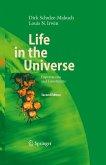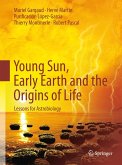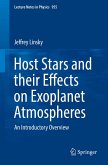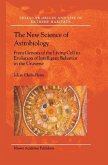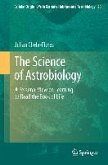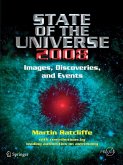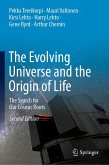This class-tested textbook examines the basic elements of living systems: energy, chemistry, solvents, and habitats in crucial depth. These elements define the opportunities and limitations for life on other worlds. The book argues that life forms we would recognize may be more common in our solar system than many assume. It also considers, however, the possibility of exotic forms of life based on backbones other than carbon, liquids other than water, and energy other than light. The authors offer an operational definition of life and summarize prevailing thoughts on plausible pathways for the origin of life on Earth and other worlds. They discuss remarkable adaptations to extreme environments, the nature and detection of geo- and biosignatures, the future and fate of living systems, and suggestions for the optimization of future exploratory space missions.
The entire text has been thoroughly updated in this third edition, with new sections added on exoplanets, synthetic life,the search for extraterrestrial life, and a tour of the bodies in our Solar System for signs of conditions conducive for life. While informed speculation in this emerging field cannot be avoided, the authors have clearly distinguished between what is known as fact and what are reasonable expectations. They present an objective assessment of the plausibility of life on other worlds that is broad and deep enough for the expert and for use as an advanced text in astrobiology, while avoiding scientific jargon as much as possible to make this intrinsically interdisciplinary subject understandable to a broad range of readers.
The entire text has been thoroughly updated in this third edition, with new sections added on exoplanets, synthetic life,the search for extraterrestrial life, and a tour of the bodies in our Solar System for signs of conditions conducive for life. While informed speculation in this emerging field cannot be avoided, the authors have clearly distinguished between what is known as fact and what are reasonable expectations. They present an objective assessment of the plausibility of life on other worlds that is broad and deep enough for the expert and for use as an advanced text in astrobiology, while avoiding scientific jargon as much as possible to make this intrinsically interdisciplinary subject understandable to a broad range of readers.
Dieser Download kann aus rechtlichen Gründen nur mit Rechnungsadresse in A, B, BG, CY, CZ, D, DK, EW, E, FIN, F, GR, HR, H, IRL, I, LT, L, LR, M, NL, PL, P, R, S, SLO, SK ausgeliefert werden.
From the reviews:
"I would be happy to use this as a text when teaching undergraduate level astrobiology and would certainly recommend it as a good introduction for postgraduates." (Monica M. Grady Meteoritics and Planetary Science 2005, vol. 40, page 507-508)
"This book is [...] an in-depth, critical look at the chemical and physical requirements of known living; it also considers the possibilities of some highly speculative environments and living systems. The writing is excellent and, despite the technical nature of the subject, should be understandable for those with minimal exposure to math, physics, chemistry, and astronomy." (P. R. Douville, Choice May 2005, vol. 42, page 459)
"This book provides an articulate overview of Astrobiology in the Springer Advances in Astrobiology and Biogeophysics series. It contains an introduction chapter that is essentially a summary of the book, a chapter outlining definitions used, then seven more chapters describing the history of life, known energy sources for life, types of building blocks, potential solvents, known and possible habitats, examples of exotic life forms, and signatures of life. This is an excellent Astrobiology primer and I highly recommend this as a good reference for all scientists in the field of Astrobiology." (Janice Bishop, Icarus 178 (2005), page 289-290)
"'In searching for life beyond Earth, we would be well advised to except the unusual'. Here in a nutshell ... is the central theme of this timely and interesting book. ... This is an open-minded and engaging book. ... it is written in an engaging style. ... Astrobiology is a growing field, but any enthusiast will want this sensibly priced volume to hand." (Simon Conway Morris, Geological Magazine, Vol. 144 (3), 2007)
From the reviews of the second edition:
"Life in the Universe examines exactly why alien life is expected to be most probably carbon-based with water as the biosolvent, but alsodiscusses other proposed alternatives in non-terrestrial-like environments ... . an essential reference book for any astrobiologist's bookshelf, and unique in several important respects. For the sections on biochemical alternatives and energy-generation alone, virtually ignored in other books, I would heartily recommend Life in the Universe and have already referred back to it a number of times myself." (Lewis Dartnell, The Astrology Society of Britain, February, 2009)
"The goal of the authors is ... to construct a likely scenario for the origin of life on Earth, to project onto other worlds this scenario, and then to identify the signatures of life that should be the targets of any space exploration that seeks to find life other than on the Earth. ... list of references will be useful to students. In conclusion, if you are curious to know how we got here, where we are going ... this book is for you." (Fernande Grandjean and Gary J. Long, Belgian Physical Society Magazine, Issue 1, 2010)
"I would be happy to use this as a text when teaching undergraduate level astrobiology and would certainly recommend it as a good introduction for postgraduates." (Monica M. Grady Meteoritics and Planetary Science 2005, vol. 40, page 507-508)
"This book is [...] an in-depth, critical look at the chemical and physical requirements of known living; it also considers the possibilities of some highly speculative environments and living systems. The writing is excellent and, despite the technical nature of the subject, should be understandable for those with minimal exposure to math, physics, chemistry, and astronomy." (P. R. Douville, Choice May 2005, vol. 42, page 459)
"This book provides an articulate overview of Astrobiology in the Springer Advances in Astrobiology and Biogeophysics series. It contains an introduction chapter that is essentially a summary of the book, a chapter outlining definitions used, then seven more chapters describing the history of life, known energy sources for life, types of building blocks, potential solvents, known and possible habitats, examples of exotic life forms, and signatures of life. This is an excellent Astrobiology primer and I highly recommend this as a good reference for all scientists in the field of Astrobiology." (Janice Bishop, Icarus 178 (2005), page 289-290)
"'In searching for life beyond Earth, we would be well advised to except the unusual'. Here in a nutshell ... is the central theme of this timely and interesting book. ... This is an open-minded and engaging book. ... it is written in an engaging style. ... Astrobiology is a growing field, but any enthusiast will want this sensibly priced volume to hand." (Simon Conway Morris, Geological Magazine, Vol. 144 (3), 2007)
From the reviews of the second edition:
"Life in the Universe examines exactly why alien life is expected to be most probably carbon-based with water as the biosolvent, but alsodiscusses other proposed alternatives in non-terrestrial-like environments ... . an essential reference book for any astrobiologist's bookshelf, and unique in several important respects. For the sections on biochemical alternatives and energy-generation alone, virtually ignored in other books, I would heartily recommend Life in the Universe and have already referred back to it a number of times myself." (Lewis Dartnell, The Astrology Society of Britain, February, 2009)
"The goal of the authors is ... to construct a likely scenario for the origin of life on Earth, to project onto other worlds this scenario, and then to identify the signatures of life that should be the targets of any space exploration that seeks to find life other than on the Earth. ... list of references will be useful to students. In conclusion, if you are curious to know how we got here, where we are going ... this book is for you." (Fernande Grandjean and Gary J. Long, Belgian Physical Society Magazine, Issue 1, 2010)
"This book does a comprehensive job of touching on the many disparate topics that constitute the discipline. ... a useful book, which provides a starting point for those readers wishing to explore the primary literature in astrobiology. Summing Up: Recommended. Advanced undergraduates through faculty and professionals." (P. K. Strother, Choice, Vol. 56 (11), July, 2019)



